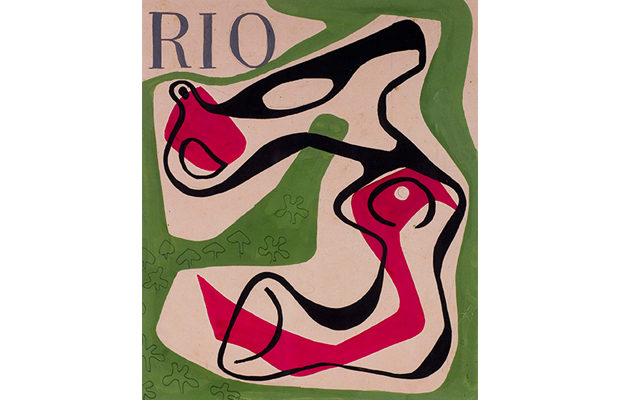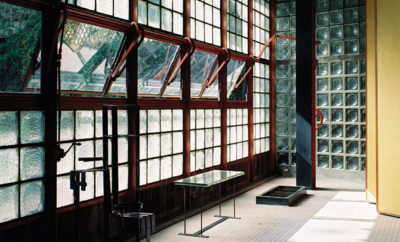 Roberto Burle Marx, cover design for the magazine Rio, 1953, gouache on paper. SÌtio Roberto Burle Marx, Rio de Janeiro.
Roberto Burle Marx, cover design for the magazine Rio, 1953, gouache on paper. SÌtio Roberto Burle Marx, Rio de Janeiro.
Exhibition
Inside the World of Brazilian Modernist, Roberto Burle Marx
Two images form bookends for the marvelous Roberto Burle Marx show at the Jewish Museum. The first is a 1920s tangle of tree branches, a charcoal drawing the artist made as a teenager, looking through a garden thicket at the house where his cultivated and cosmopolitan family lived in the Leme neighborhood of Rio de Janeiro. The second is a photograph from the 1980s in which Burle Marx, once described by the New York Times as “this bear of a man,” stands with a paintbrush in the loggia of his revered Sitio, the abandoned coffee plantation he purchased in 1949. (Now part of Brazil’s National Institute of Historic and Artistic Heritage in Guaratiba; it’s about an hour’s drive from downtown Rio.) The photo catches him painting a tablecloth to be used at one of his bountiful and meticulously arranged meals where guests might include a poet, an architect, or members of the Yawalapiti tribe from the Amazonian region of Alto Xingu. A chandelier he constructed—real fruit and flowers affixed to a metal frame—hangs overhead, geometric patterns of his azulejo tiles decorate the walls, and the door opens out to his vast gardens of tropical and semitropical plants.
Both the youthful drawing and the photograph from his last years demonstrate the inspiration Burle Marx derived from the natural beauty of Brazil—its patterns, textures, the bold sculptural forms of its philodendrons, palms, and elephant ears—and his impulse to pay homage through art. This is the theme of the current retrospective, which showcases his abundant talents and energy. Often called the father of tropical garden architecture, he was a painter, sculptor, botanist, environmentalist, an architect of public space, a collector of art, a baritone vocalist, the creator of “an imaginary cookbook,” and a designer of ceramics, glass, mosaics, tapestries, jewelry, costumes, set design, and carnival decoration.
The exhibition features many of his garden designs painted with gouache (and sometimes automobile paint) on paper, works of modern abstract art in their own right. An early design for the Minister’s Rooftop Garden, at the Ministry of Education and Health, Rio de Janeiro, 1938, precedes Matisse’s famous cutouts chronologically but demonstrates similar curvilinear, almost-figurative shapes and bold, jazzy (better, samba-like) swathes of color. On paper Burle Marx often chose a palette of corals and melon tones, consistent with the fruits, flowers, and filtered light of the tropics. The corresponding photograph of the rooftop garden shows how he translated painted biomorphic shapes into organic color fields of vegetation growing at varying heights, interlaced by undulating footpaths, and anchored with sculpture. The graceful lines of the walkway create patterns for movement that are simultaneously dynamic and thoroughly modern.
The centerpiece of the show is an eighty-seven-foot-long wool tapestry created in 1969 for the Santo André Civic Center. I was told it took fifteen people working eight hours to hang it properly. Abstract but suggestively symbolic (one can read it as ageometric design or an Edenic landscape with hints of primitive or totemic figures), it’s designed like the garden plans with attention to shape, texture, light, and darkness. Against a smoky blue background, flat, interlocking cubistic forms are interspersed with dots and lines and areas that are raised like braided grass. Executed when Burle Marx was at the center of his career, the work is joyous and full of vitality, and one can imagine it as an approximation of that first garden where the world of nature came in contact with mankind.
Roberto Burle Marx: Modernista Brasileiro on view at the Jewish Museum: May 6–September 18, 2016











